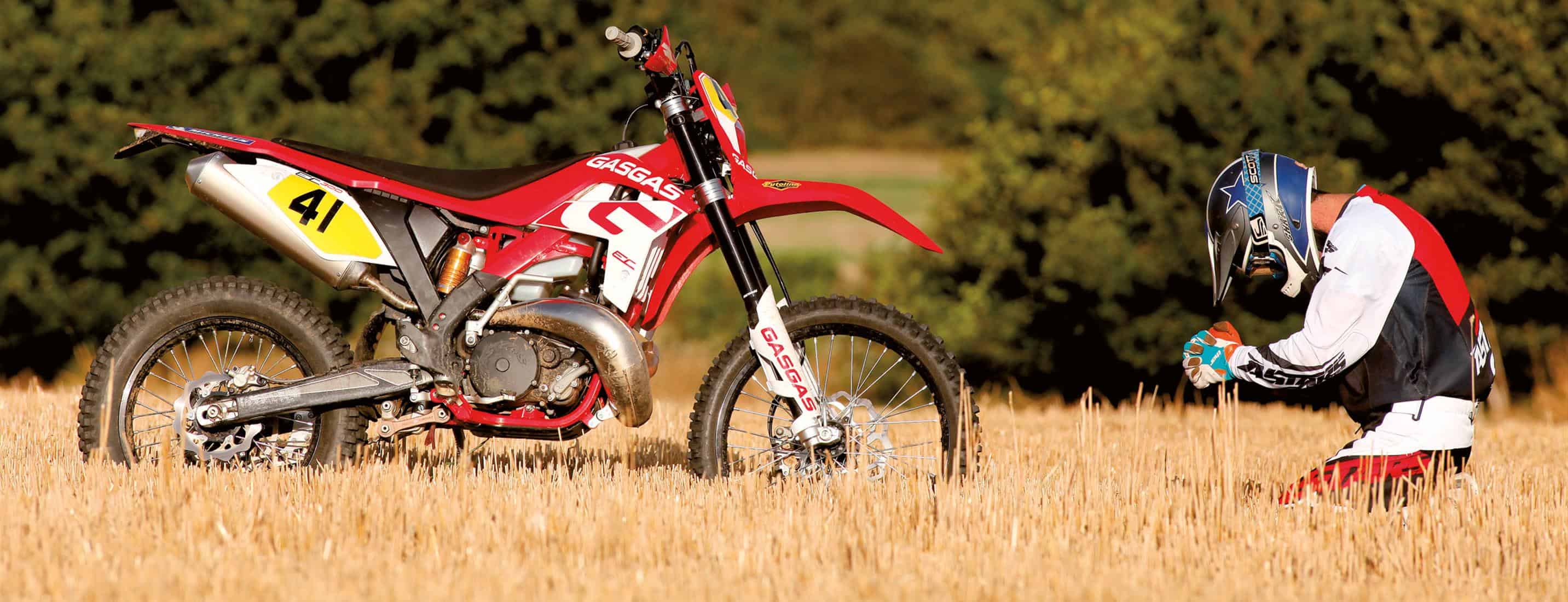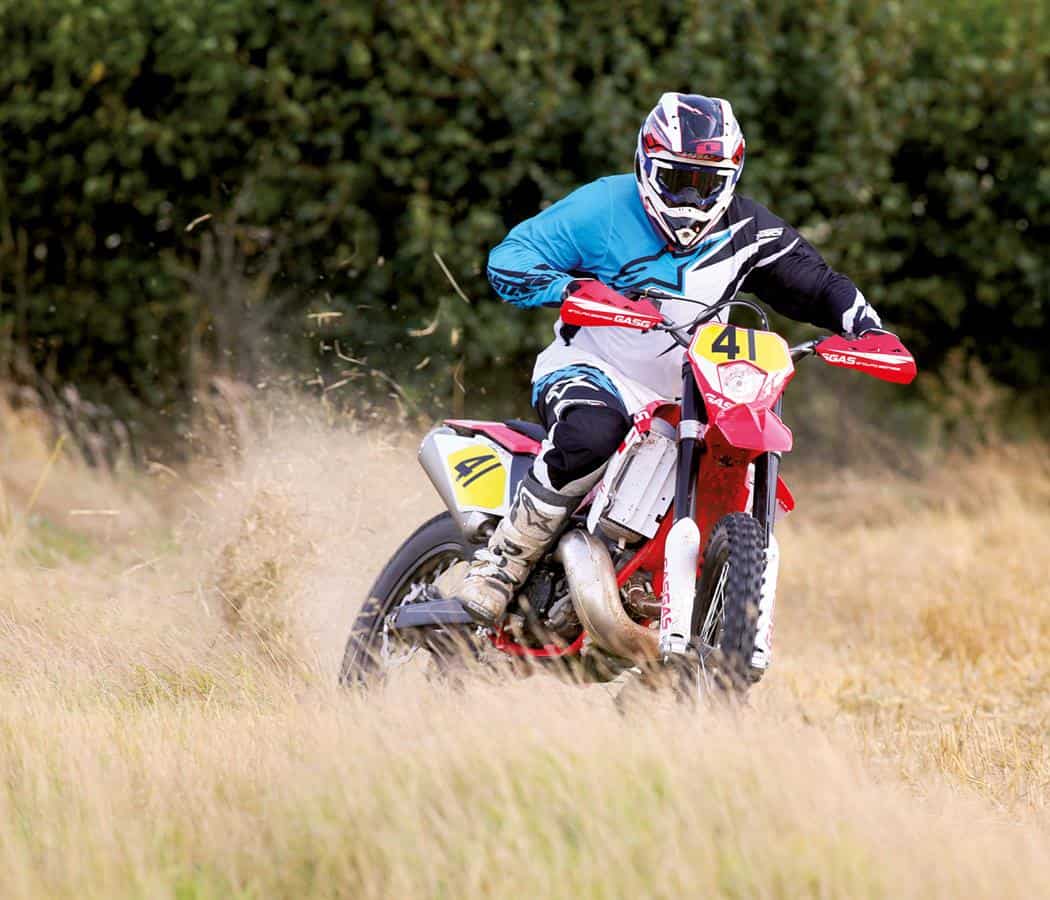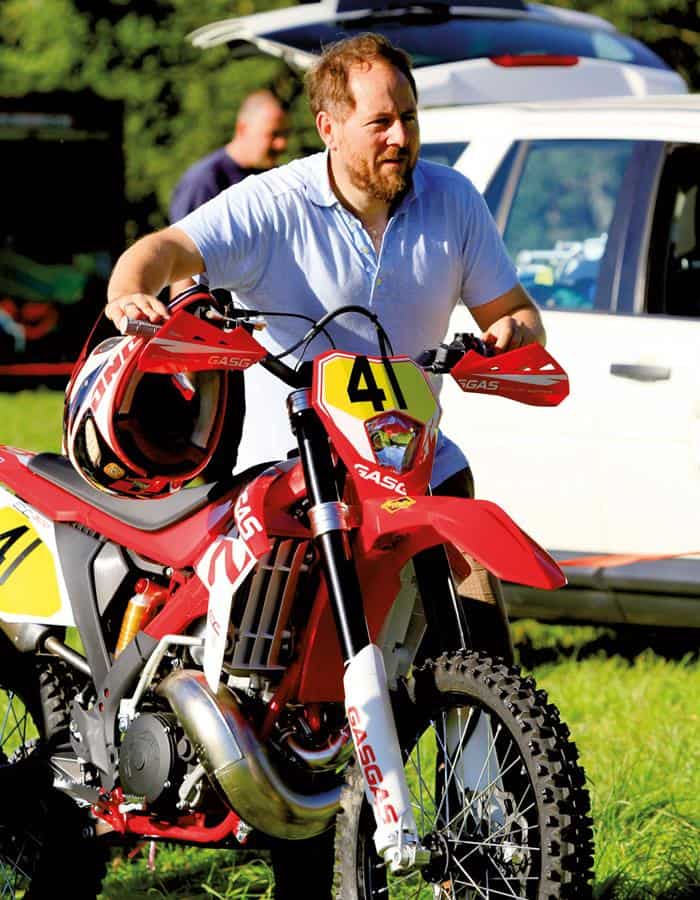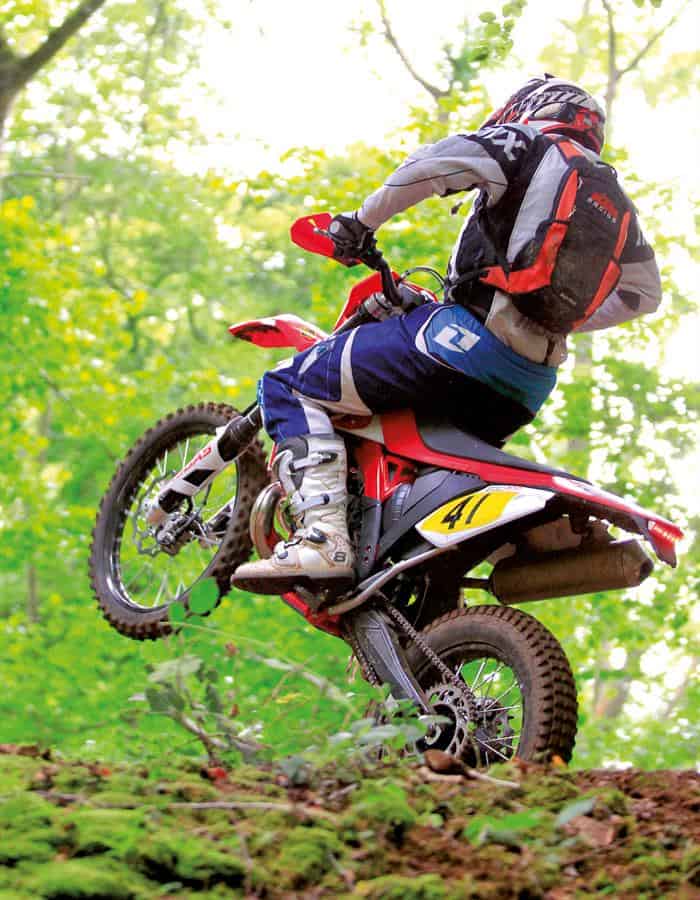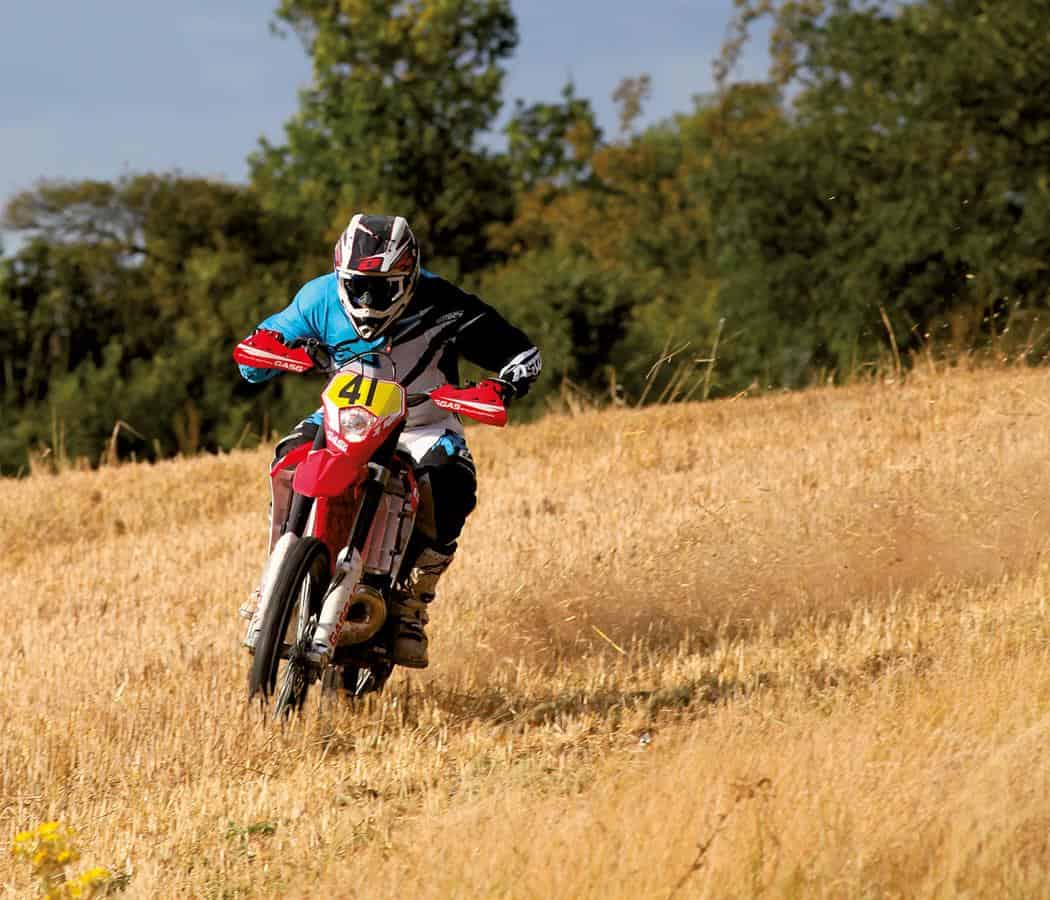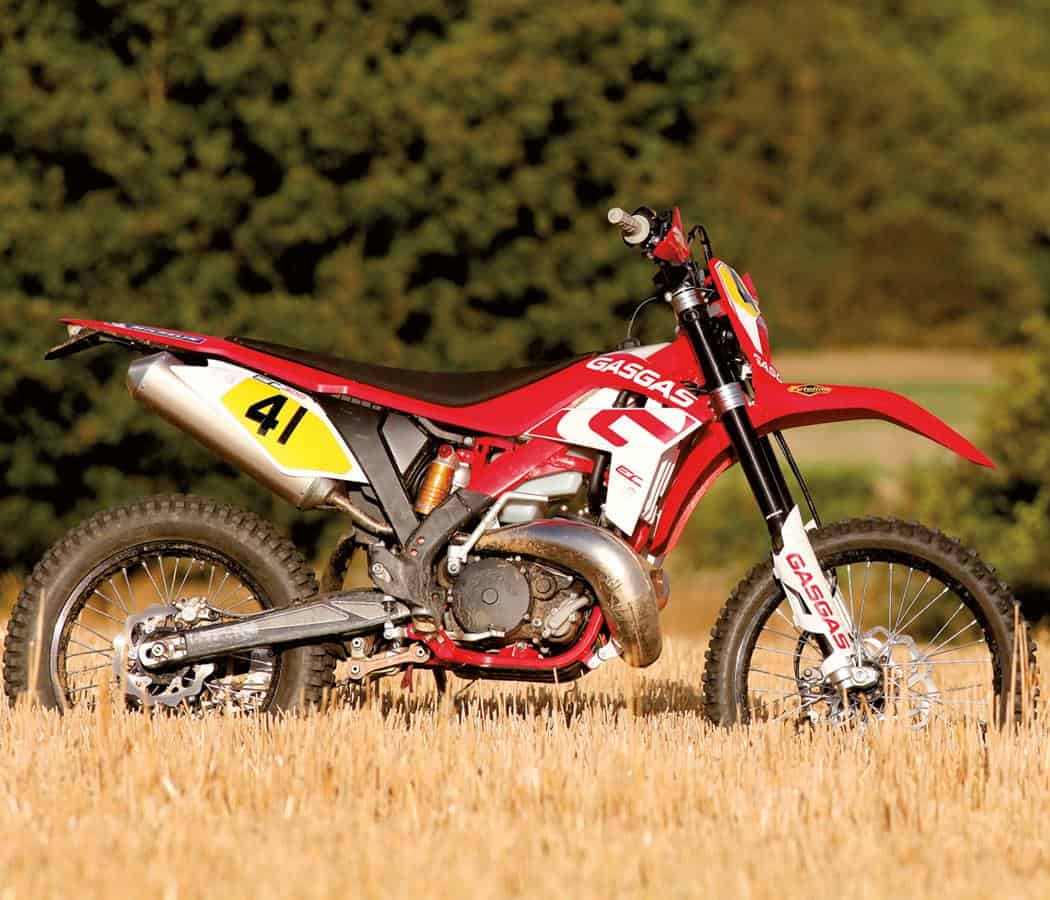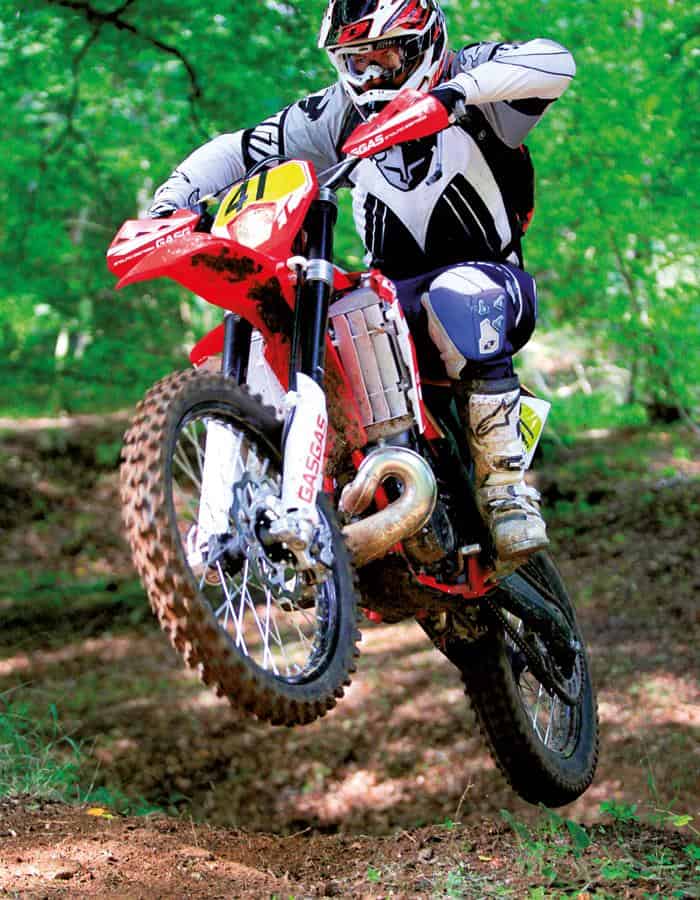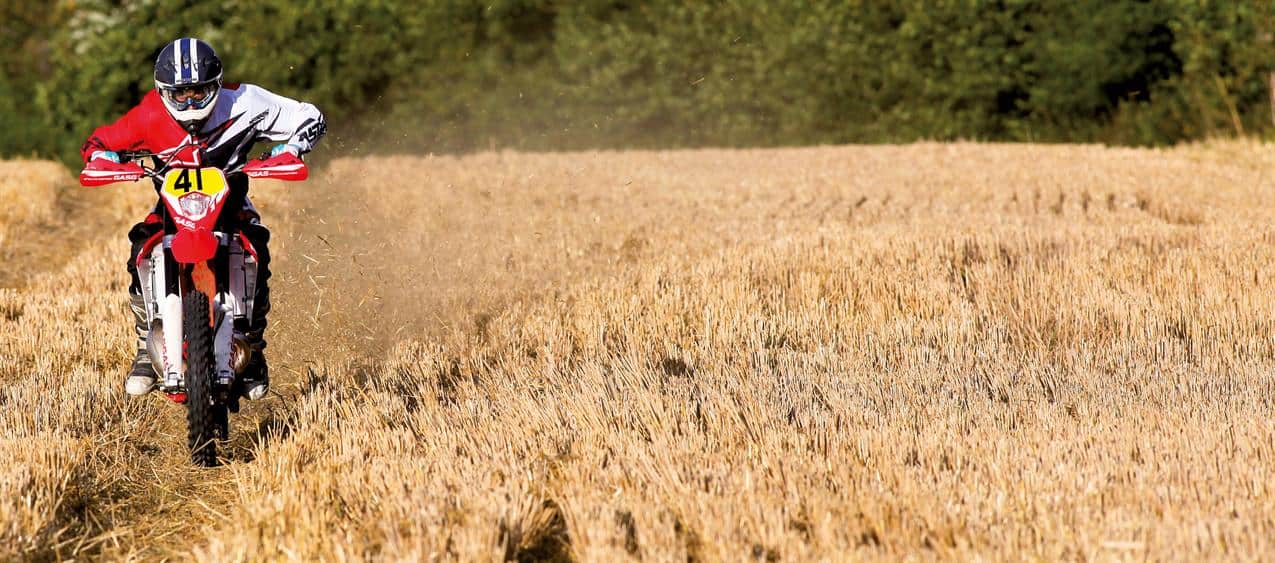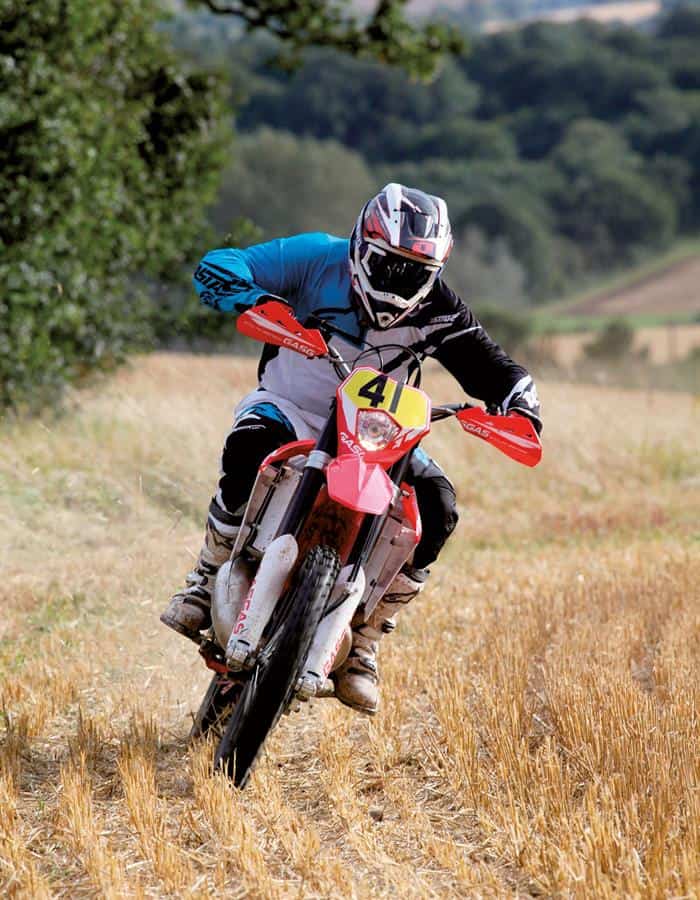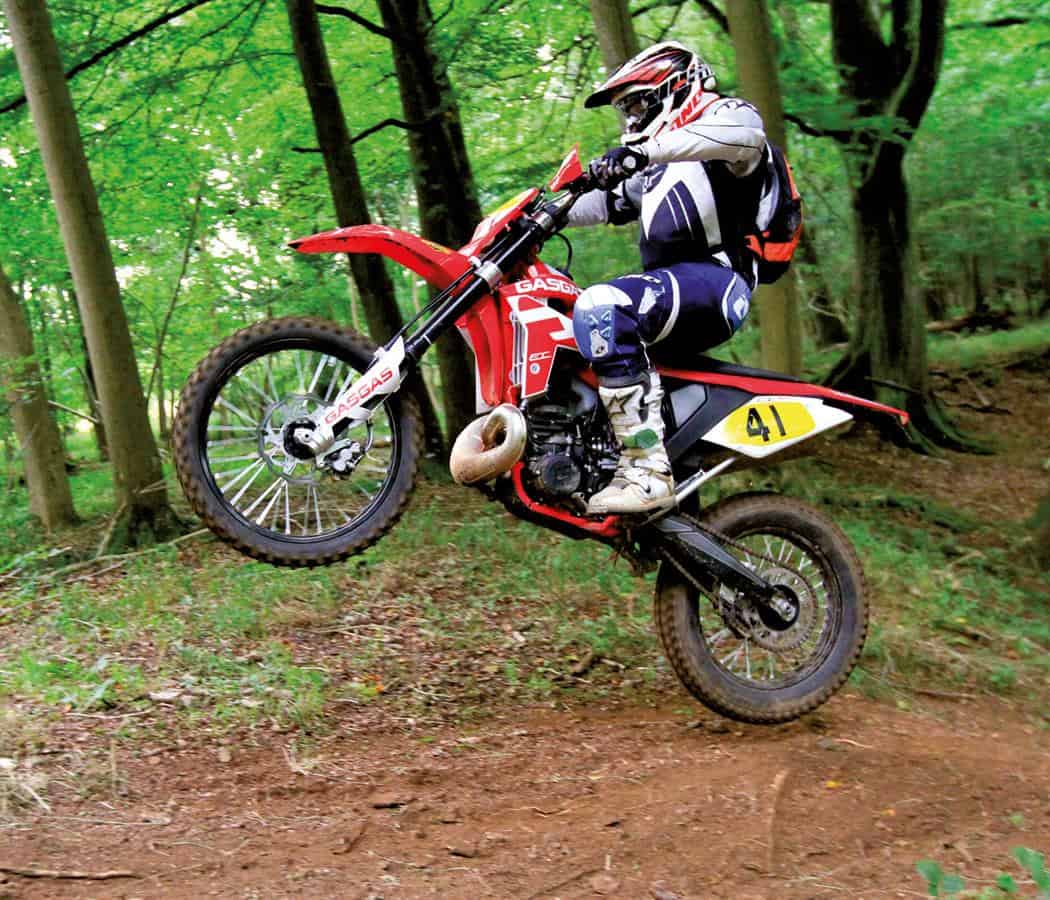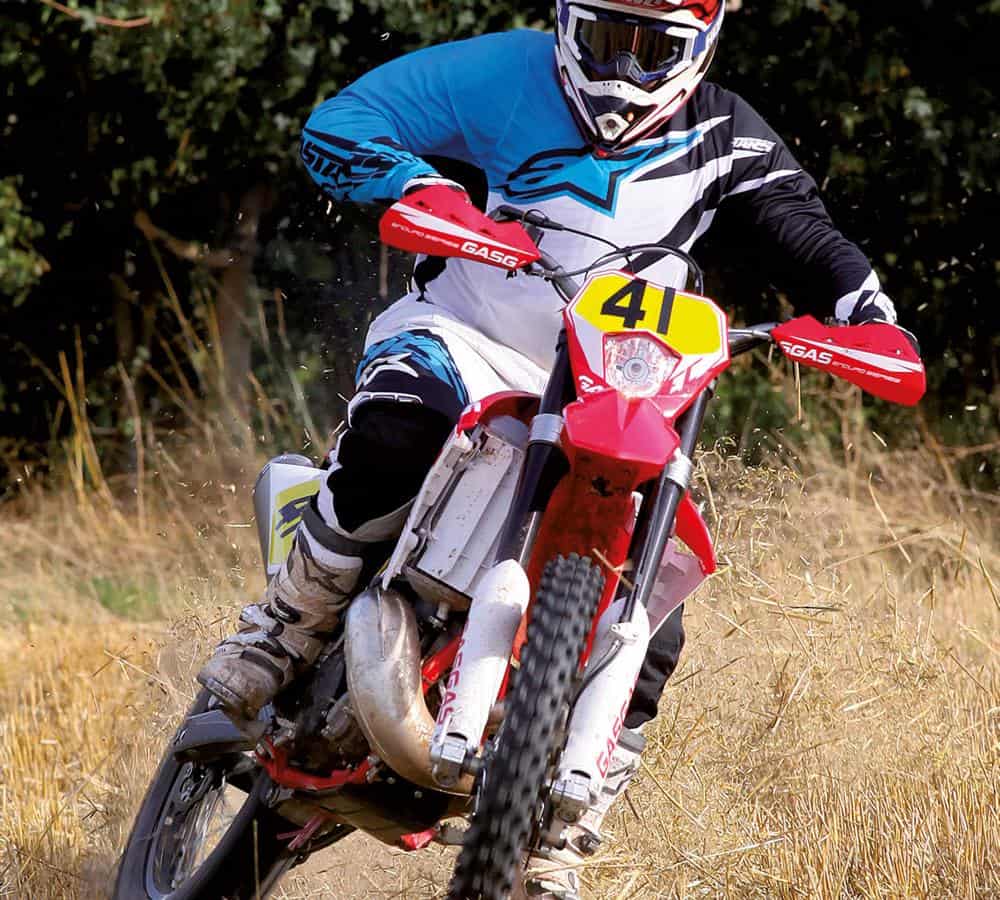We all know 300s are bought for trailriding on, not racing. Well not unless your name’s Nambotin or Knight. But rumour has it that the 2013 Gas Gas EC300 is not only well built, it’s also one of the easiest 300s to ride and race. RUST couldn’t resist a challenge…
The surprise announcement last month that Italian manufacturer Beta has developed and launched its own range of 250 and 300cc two-stroke enduro bikes, brings the total number of mainstream factories building enduro strokers up to four… Well, five if you count Husaberg as distinct from KTM.
It’s interesting to note all five factories are European – the Japanese having long-since abandoned the competition two-stroke engine on the spurious grounds of environmental impact (conveniently ignoring the fact it requires far more energy and raw materials to construct a complex four-stroke engine in the first place, than a much simpler two-stroke).
So why have Beta entered the fray at a time when even a successful manufacturer like KTM/Husaberg are consolidating their range? It’s all about demand reveals Jochi Saur, spokesman for KTM: ‘the 300 two-stroke is our biggest-selling motorcycle, and as long as people want to buy a two-stroke we will continue to build them.’
Talk to John Shirt the UK Gas Gas importer and he’ll tell you much the same. An unashamed fan of two-strokes, Shirty’s opinion is even more direct: ‘I wish we didn’t have to sell four-strokes at all’, he told RUST in the past, ’they’re just a pain in the a[butt]. You know where you are with a two-stroke…’
Indeed we do. Relatively simple mechanically, they are not just easy to work on, but also great fun to ride thanks to their addictive power-delivery. Perhaps that’s why British dirt bikers (and northern Europeans) buy more 300s than anything else. And although worldwide 250 four-strokes outnumber 300 2Ts, that’s more a consequence of the giant Japanese factories building a number of different products in this class.
The bottom line is that we Brits love our powerful, lightweight dirt bikes. And 300cc two-strokes tick all the right boxes. Inherently lighter than a four-stroke thanks to their unsophisticated engines, there’s a bellyful of torque at your disposal for trail riding, as well as a savageness to the power delivery for when we want a motorcycle to absolutely spank us. It’s the ultimate combination in an off-road competition machine.
Just ask Christophe Nambotin who has not only wrapped up this year’s E3 Enduro World Championship on a 300cc two-stroke, but he’s also forced thumper-addict David Knight to switch from his preferred 500cc four-banger onto a 300 stroker in order to try and remain competitive.
However, these are two of the very best riders in the world, competing at the top of their game, so what chance the average rider of racing a 300 and staying in one piece? It was a question we wanted to try and answer by racing one in a timecard enduro. After all we know that most of you trail ride your 300s, but realistically are they too powerful and too aggressive for a forty-something to go racing on? We were about to find out armed with a brand new 2013 Gas Gas EC300 and a, um… forty-something!
Quality Schmality
As we reported earlier this year after flying out to Spain to test the 2012 machinery, Gas Gas has had a pretty torrid time of it in this recession. Falling demand for its products has warranted outside investment, but with that has come a critical review of the product as a whole – specifically trying to get to grips with the brand’s strengths and weaknesses in a global marketplace. The conclusion of which was that whilst there was genuine customer satisfaction with the way in which the products perform, top of the list of ‘complaints’ was the lack of quality, which simply didn’t match up to Austrian standards of build.
Gas Gas began addressing these issues with the 2012 models, restyling their bikes with smarter looks. And in our opinion the Gasser is now the best-looking enduro bike currently available. But much more importantly they set about improving the quality of the finished product: plastics, fasteners and pretty much all the bike’s components came in for critical attention.
So it was a bit of a surprise to discover whilst prepping the latest test bike prior to racing, that the lovely Magura clutch perch and lever had disappeared – and with it the 8mm single bolt fixing that matched the 8mm fixing on the Nissin brake perch – replaced with a cheaper AJP part sporting that same old socket-headed allen-bolt that Gassers used to use back the dark ages. Meaning once again Gasser owners have to swap between tools whenever they want to fractionally adjust their levers.
Ferchrissakes……..!!! Did the Gas Gas factory learn nothing from their internal review of quality issues? Gasser importer John Shirt tells us he’s had complaints from British customers that replacement Magura levers work out more expensive than the AJP ones. What…? Does no-one loosen off their levers anymore, or ride with handguards?
I mean even if they are more pricey for the customer who breaks one, is that really what’s driven the factory to go back to the cheaper AJP item? Of course not. They’ve cut costs and cut quality, and in doing so, instantly set themselves back five years in the battle for customer loyalty. Talk about spoiling the ship for a ha’peth of tar…
Do you hear KTM customers complaining about the price of quality levers? No, because they’re too busy laughing into their KTM-branded helmets whilst watching Gasser owners running around trying to find the right tool for the job. For heaven’s sake Gas Gas, the whole reason the orange marque instils such customer loyalty in its brand is because owners can see and appreciate the continuing quality of the products they produce. It ain’t rocket science.
And whilst I’m on this subject, can someone please inform Gas Gas how to build a working side-stand. One which doesn’t fold up of its own accord every time a vole coughs somewhere in the nearby vicinity; and which doesn’t have a foot on it which could burrow its way into freshly laid tarmac, let alone soft ground.
Talking these quality issues through with the importer he reasons: ‘Yeah but how often does an owner have to adjust his clutch lever, Si?’
‘Every frickin time it falls off its poxy sidestand!’ I want to reply, but think better of it.
At least there’s some positive news to report elsewhere with regard to the 2013 models. I guess the first and most important of which is that the rear subframe has been re-engineered to remove the need for the X-shaped brace that required five bolts to be undone in order to swap out an air-filter!
The air-filter is now accessed simply by removing a single seat fastener which for 2013 is located through the top of the saddle rather than from underneath a muddy rear fender. And although the bike we were testing was a kickstart-only model, on the electric-start bikes the battery box is now part of the seat, which also saves time and effort during filter changes.
Also on that score the kickstart lever has been reinforced for 2013 (you may recall we managed to badly bend a kickstarter when we tested a 250 at a three-day enduro in Burgundy earlier this year), to such an extent that it made starting the bike seriously difficult. This time we had no such problems, though doubtless the slightly lower seat on the 2013 models helps here too, making it even easier to get your foot properly over the kicker.
Other improvements include a reinforced front mudguard, stronger rad panels (they were decidedly flexy on the 2012s) and are now secured by bolts. Likewise the new shaped rear side-panels, and joy-of-joys the bike finally comes with proper plastic frame guards instead of sticky-back-plastic imitations!
There’s six-degrees more steering lock for threading your way through narrow trees (very useful), a return to an aluminium clutch cover (better cooling), a revised suspension linkage (offering better traction and a lower seat), a slightly reshaped fuel tank (with a better fit), new top chain roller (complete with bearing) plus a return to good old Marzocchi 45s on the front (all good).
Wear the Fox Hat
Swindon & District MCC’s Foxwell Enduro is a classic timecard event held in late summer in a small part of the magnificent 14,500 acre Bathurst Estate at Cirencester Park in Gloucestershire. This huge sporting estate is home to the annual Corinium Enduro as well as countless other horse and country-pursuit type events – indeed whilst the enduro was going on there was also a polo event happening on one of the estate’s FIVE polo fields.
With the whole race set in beautiful deciduous woodland, trials tyres were deemed obligatory. The Swindon club had plotted a brilliant 13 mile lap that included a superb five minute long special test ridden on each of the five laps, and with the going very reminiscent of the Breckland enduro (only much warmer and a bit more open), the course was one of the best I’ve ridden.
With sunny weather greeting our arrival in the paddock, and an even warmer welcome at the signing on and scrutineering, I was looking forward to an enjoyable day’s testing. I rarely get nervous before racing these days, but I must admit to feeling a touch anxious about maintaining my energy levels (and pace) for five hours on a lairy 300. Despite Gas Gas’s reputation for making bikes with a very linear power delivery, a 300 is still a helluva beast when you start getting tired.
I was pleased to find the Gasser fired first kick with a touch of choke, and waited on the startline for about 30s to let it warm up before heading into the first lap. I’d set the switchable ignition curve to the wet-weather setting for the first lap as I’d figured it might be slippery in places. In fact the conditions were nigh-on perfect and as the course wound through this delightful ancient woodland, the loamy soils quickly began berming up on all the corners.
It wasn’t particularly bumpy which was just as well as the Gasser felt firmly suspended on first impressions, whilst the 300’s engine revealed ultra-crisp carburetion perfectly complimenting an amazingly linear power delivery. In other words you knew precisely what you were going to get as soon as you opened the throttle. I know that might sound an obvious requirement for a dirt bike, but believe me it’s not as common as you might think.
We try and dyno-test as many bikes as we can, and it’s only when you do that you get an empirical readout of a bike’s actual power delivery (and output). That’s when you discover plenty of bikes actually produce a fairly ‘lumpy’ power delivery with peaks and troughs in their curves that makes riding them trickier than it need be. But take a look at the power and torque curves of this EC300 and you’ll find a perfectly straight curve that begins at 3500rpm and remains resolutely smooth all the way up to 7500rpm.
And that’s exactly what it feels like to ride. It’s not only linear it’s also incredibly easy for a 300 and even when the powervalve opens up and the bike lunges towards the horizon you’re not having to fight for control. Mind you the front comes up pretty quickly when you wind on the power. There was one section towards the end of the special test where a tight off-cambered right hand corner taken in second gear, exited onto a long straight. As you came out of the corner and opened the throttle the front end came up and stayed up for two gearchanges before settling back down again.
Brake hard for the next turn (another right hander) and get on the gas early and watch the front lift again. This was a much shorter straight and was followed by another right-hander onto yet another long straight. Up came the front for two more gearchanges, before you throttled off for a 90-degree (but sweeping) left-hander. Back down two gears and then open the throttle as hard as you dare on the exit. The rear end stepped out in the soft loam and as soon as it found grip again, up came the front once more. I don’t mean up high, I mean maybe a foot or so off the ground so that you could continue to accelerate hard with the rear tyre digging into the dirt. Awesome.
Despite the 300s unwavering torque you’re constantly up and down the gearbox and you can only really hold onto gears for a few seconds before selecting another cog. Fortunately the Gas Gas has one of the best transmissions I’ve ever tried and you barely even felt the next gear go home – with or without using the clutch.
Despite the entire course being woodland-based the variety of terrain on offer was amazing. There was long rutted firebreaks where you pushed as fast as you dare in the ruts; a section consisting of three or four quite deep bombholes ridden in fast succession where you had to climb in and jump out of them as well as a good few ditches to cross and lots of extended single-track through fairly tight trees.
It was the tight trees I was least looking forward to on a bike with nigh-on 40hp at its disposal. But I needn’t have worried, the Gasser is such an easy handling bike its makes light work of even the narrowest of gaps and the 2013’s additional steering lock meant you could afford to stay up on the pegs and turn fairly slowly – trials-style around tight obstacles.
The first three laps were pretty comfortable on time but then things began tightening up considerably with two tight checks ridden in quick succession. A lap before I’d come into the pits to refuel (just to be on the safe side); grabbed a drink and softened off the Gasser’s rear suspension slightly. Both ends still felt pretty firm to me and if I had a criticism of the way the Gasser was set up to race, it would be that it definitely felt on the firm side of plush. Not harsh you understand, nor choppy, nor even uncomfortable, just firm. Or maybe firm for my speed would be more accurate. Certainly if you were only trailriding you’d want to soften it out on the clickers.
If I’d had more time to play, I probably would’ve clicked out the adjusters on the forks as well. But as it was, I didn’t. I just had time to flick the mapping switch over to ‘sunshine’ and then dive through the check on my minute.
That was it, it was all or nothing now. With an average of 38-40minutes for the first few laps (though that did include queuing for anything up to five minutes at the start of the special test), this next one was ridden as fast as possible with the tight entrance to the test having been removed. With just 32 minutes available to try and make it around the lap to the next check, I knew I had my work cut out to stay on time, but I set off on the Gasser determined to try and improve my pace around the course.
Riding much harder than before, the Gasser responded ever better to rider input and incredibly felt like a tiny toy in my hands. It railed the berms, exploded out of turns and absolutely charged around the course way better than I’d expected, and I still wasn’t feeling particularly shot, despite having been in the saddle for three hours. That’s when I finally understood the 300 principal…
When things got tough I’d expected the 300 to make life harder for me, but in fact the reverse was true. It just felt smaller, more direct, and kept on delivering that seamless wave of performance that made the riding seem effortless. I had a huge look of determination on my face as I got to the very last section of trees and saw that I was approaching my minute – would I make it in time?
But just as I got to within 200m of the checkpoint the clock turned over and I dropped a minute. Shoot! No matter I still had another fast lap to polish off before I could finally hand in my timecard. Heading back out onto the course I pushed – if anything – even harder than before, and nailed the final 34 minute lap in well under 32 minutes. If only I’d have done that one lap before…
What a fabulous day. What an awesome bike. Powerful, polished, and better than I dared hope. How good is its handling? Well any bike that let’s me push to my personal limits without tipping me off the entire day, has got to be pretty special in my book.
I love the 2013 Gasser EC300, even more than I liked the much-improved 2012. It’s a great bike. A bike you can trailride all day or have fun racing on without risking life and limb. Fast, strong, well built and like pretty much every Gas Gas ever built – brilliant to ride I really can’t recommend it highly enough. With one exception…. Gas Gas, change that poxy AJP clutch perch back to a nice Magura, PLEASE!
Second Opinion
It was a glorious autumn late afternoon, the soft yellow light reflecting off the stubble. A command rang out.
‘And Kneel.’
‘What….?’ Said Alex, the recipient of this instruction.
‘I SAID KNEEL.’
Alex slowly sank to his knees.
‘Now pray.’
‘What…..?’
‘I SAID PRAY!’
Reluctantly Alex put his hands together and bowed his head. Si took a few shots and glared at the camera screen. Standing back from the creative process I giggled happily inside my helmet. It was an amusingly surreal scene.
The object of reverence was the new Gas Gas EC300. An unlikely Idol you might think. Certainly I was not expecting any revelations when I slung a leg over it half an hour earlier. I have ridden a few Gasser 300s over the years and always enjoyed them. They combine a gentlemanly engine with sweet handling and good brakes. The general impression was always of a pleasant but slightly bland machine that will always look after you. They also had a comparatively rough finish and a somewhat depressing predilection for shedding parts.
With these condescending thoughts in mind I hopped on and goosed the 2013 EC300 with an authoritative handfull. The bloody thing took off like a firework. As the horizon raced towards me I only had time for a quick glance at the speedo, 110kmh, before it was time to shut off. Followed by some heavy braking to avoid going through the hedge.
A manic cackle and it was time to do it again. This time I saw 120kmh. As well as the sensational top end it also has plenty of smooth low down grunt for more technical riding. The fine handling and braking remain as well. The fit and finish appear to be far better than I remember.
The only bad point I noticed was the adjustable lock stops on the bottom yoke. They were allowed to hit the unprotected frame and the paint was already starting to chip. I don’t know what Gas Gas have done to their old stager but they have certainly produced a bike that makes you take notice. Effortlessly capable and with bags of character it is a fabulous machine.
If you are one of those people that loves the two-stroke rush and want something a bit different then you really ought to try one. Reverand Richard of Bottshire Abbey

